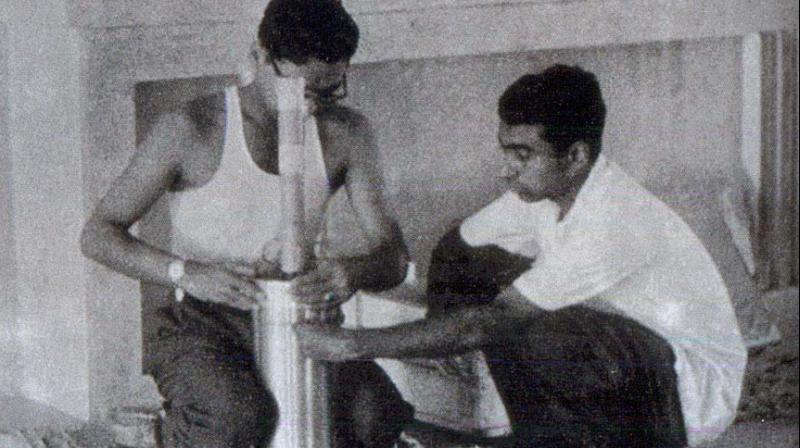Manned space missions to be of lesser priority: Scientist

Chennai: On a sweltering day in Thiruvananthapuram, crouched on the floor, two engineers — one of them shirtless and another looking anxious — seemed busy fixing a payload. The scene caught the attention of famous photographer Cartier Bresson who immediately captured the moment.
The simple picture of the two engineers at work later attained iconic status after one of them became the President of India in 2002. The shirtless engineer in that picture was his close friend R. Aravamudan.
R. Aravamudan , one of the pioneers of Isro who was worked at the organisation from its very inception and his wife Gita Aravamudan have come out with the book Isro – A Personal History covering more than half a century of the evolution of Indian Space Research Organisation.
In an interview with Deccan Chronicle, he discussed various issues like the significant event in Isro’s history, why Kalam remained unmarried and the mysterious death of Vikram Sarabhai.
Q. Can you tell about any one event which has transformed Indian space programme to its current position from its humble beginning?
The very first successful launch and orbiting of a satellite by SLV rocket gave a big boost to the scientific community. There were also failures, but these gave us very valuable data to improve and make the systems reliable.
Q. You and APJ Abdul Kalam and few others were handpicked by Vikram Sarabhai to be trained at NASA. What was the training like and whether NASA training has helped the scientists in building rockets and subsystems?
We had just selected a place for sounding rocket programme in Kerala. So we were sent to NASA to get trained in 1963. The scope of training at NASA was very limited and confined to operating a small sounding rocket facility, mostly a kind of operator’s training. No theory or design was taught.
Q. We heard stories that NASA did not allow Indian scientists anywhere near their satellite programmes or launch vehicles during that training. Did NASA’s perception change after our initial success in space programmes?
Unfortunately, no. The US always suspicious about our space programmes. They torpedoed our collaboration with Russians in developing cryogenic engines for GSLV rockets. We could not import anything connected with rockets, missiles and satellites. They put the equipment in that banned category. There was no interchange between NASA and ISRO for very long time. Only after we have achieved our own indigenous capability with PSLV rockets, they came forward for collaboration. They also collaborated with our moon mission.
Q. You and Kalam were close friends. You have mentioned many interesting facts about Kalam that he doesn’t know cycling, his love for Vendhya Kozhambu and about his little known ideal Atlas Shrugged hero John Galt in the book. Why he remained unmarried?
That was his personal choice, perhaps based on his devotion to work. There was a talk of his marriage during the initial years in 1963 and 1964. But as he got involved in projects as a project chief, he didn’t find time even to go home in Rameswaram. Slowly, he forgot the whole idea.
Then on he said it’s too late. We didn’t succeed in our favourite project of finding him a girl.
Q. What is the quality that helped the young rocket scientist to the post of President of India? What do you consider as the defining moment in his career?
He worked only 18 years in Isro and later moved on to DRDO to develop missiles. Kalam had the singular devotion to his work. More than anything he was a team leader.
He has got the ability to make his team work. He was on the job for 24 hours. Of course, being bachelor helped also.
That dedication aspect and single-minded work made him successful.
Q. You are one of the few scientists who met Vikram Sarabhai hours before his death. Do you see any conspiracy in his death?
No, there was nothing suspicious about the circumstances of his death. All of us were with him the previous night. The question didn’t rise at all during that time (Sarabhai passed away in his sleep). Though he was young (52 years) at the time, he had BP and was constantly working hard. Sarabhai’s death was a sudden one, no doubt about it. But even his family members didn’t raise any suspicion.
Q. Isro has missed the chance of getting the cryogenic engine in the early 1970s itself?
As I have mentioned in my book, at that time the entire focus was on getting SLV Project completed using solid propellants and we did not want to distract from our prime objective. So, the organisation did not show interest in the proposal of cryogenic engine jointly by the French firm SEP.
Q. Of all programmes of ISRO, GSLV rocket project faced many stumbling blocks in the form of US ban and infamous ISRO spy scandal. How has spy scandal affected the morale of scientists?
The US interference in our contracts with the Russians had a greater impact than the scandals. The scientists continued their work for indigenous development with greater vigour.
Q. It’s a long journey from sounding rockets to Mars Orbiter Mission for Isro. Where you want to see the space organisation go from here?
The main motivation for the space programme in India is to apply it to improve the standard of living of the people using the latest technology to leapfrog into a developed nation. With this in view, we have to improve our payload capability in both low earth orbits and geosynchronous orbits. The cost of orbiting has also to be cut down to competitive levels. The other programmes like deep space probes, manned missions etc would only be of lesser priority.

